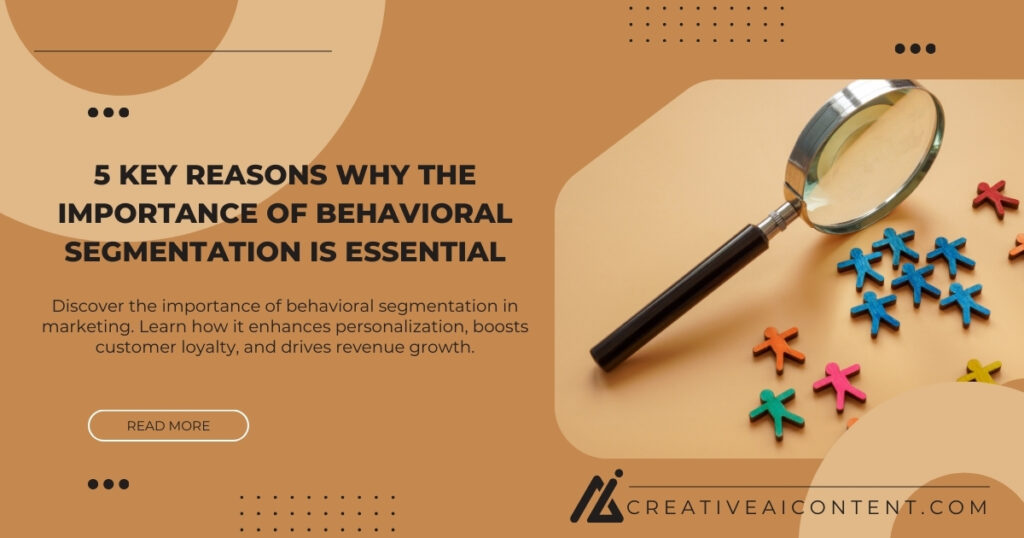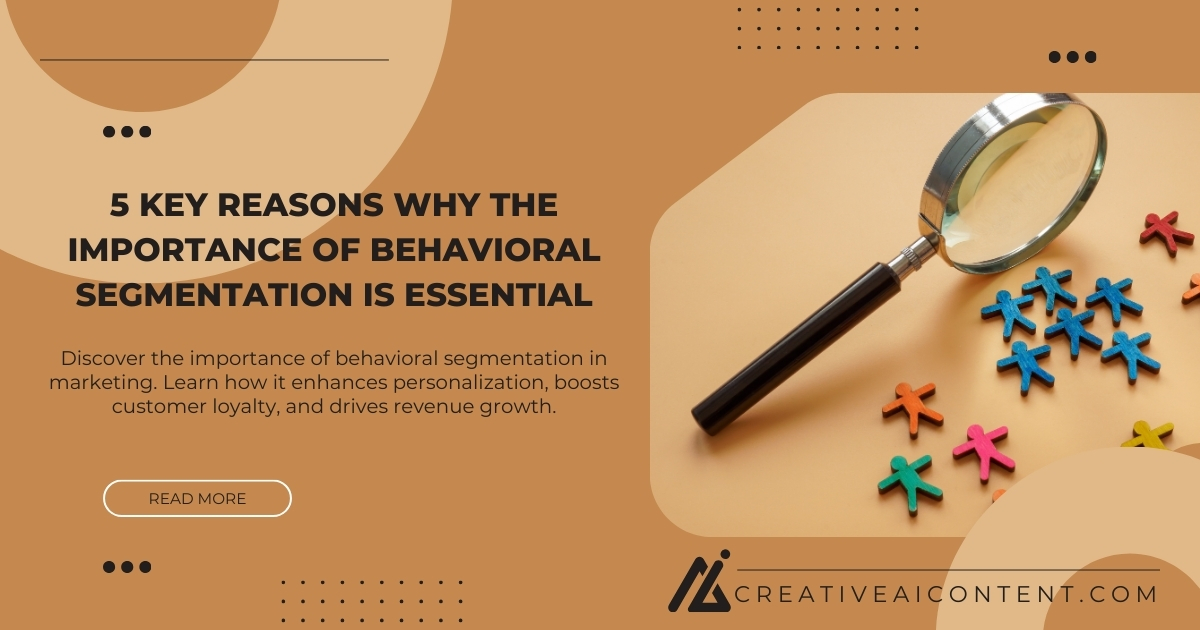Have you ever wondered why some marketing campaigns feel like they were made just for you? The secret lies in behavioral segmentation, a powerful strategy that divides customers based on their actions, preferences, and interactions with a brand. Unlike traditional methods like demographic segmentation, which focuses on static traits like age or income, behavioral segmentation delves into dynamic behaviors such as purchase history, brand loyalty, and online engagement.
In today’s fast-paced, customer-centric market, understanding the importance of behavioral segmentation is crucial for businesses aiming to stay competitive. By tailoring marketing efforts to specific customer behaviors, companies can deliver personalized experiences, improve customer retention, and maximize ROI. This article explores the importance of behavioral segmentation, its benefits, and how it outperforms traditional segmentation methods.

What is Behavioral Segmentation?
Behavioral segmentation is a marketing strategy that categorizes customers based on their actions and interactions with a brand. This approach focuses on how customers behave rather than who they are. Key behavioral variables include:
- Purchase behavior: Frequency, timing, and patterns of purchases.
- Usage patterns: How often and intensively customers use a product or service.
- Brand loyalty: Repeat purchases and engagement levels.
- Occasion-based behavior: Purchases tied to specific events or seasons.
- Benefits sought: The specific value customers seek from a product or service.
For example, an e-commerce platform might use behavioral segmentation to identify customers who frequently abandon their carts and target them with personalized discounts to encourage completion of the purchase.
5 Key Reasons Why Behavioral Segmentation is Crucial
1. Enhanced Personalization
One of the most significant advantages of behavioral segmentation is its ability to deliver highly personalized experiences. By understanding customer behaviors, businesses can tailor their messaging, offers, and product recommendations to match individual preferences. For instance, Netflix uses behavioral segmentation to recommend shows based on viewing history, significantly enhancing user satisfaction and engagement.
2. Improved Customer Retention
The importance of behavioral segmentation is evident in its ability to identify loyal customers and those at risk of churn. By analyzing usage patterns and engagement levels, businesses can implement targeted retention strategies. For example, Spotify’s “Discover Weekly” playlist, based on user listening habits, has been instrumental in reducing churn rates.
3. Higher ROI and Cost Efficiency
Targeting specific customer segments based on behavior ensures that marketing resources are allocated effectively. Campaigns tailored to high-value customers or those with specific purchasing patterns yield higher conversion rates and reduce wasted ad spend.
4. Competitive Advantage
In a crowded market, behavioral segmentation provides a distinct edge. By understanding customer behaviors better than competitors, businesses can create unique value propositions and foster deeper brand loyalty.
5. Dynamic and Actionable Insights
Unlike static demographic data, behavioral segmentation provides real-time, actionable insights that adapt to changing customer preferences and market trends. For example, e-commerce platforms can use browsing behavior to adjust product recommendations dynamically, ensuring they remain relevant and timely.
Behavioral Segmentation vs. Demographic Segmentation
While demographic segmentation categorizes customers based on static traits like age, gender, and income, behavioral segmentation focuses on dynamic actions and preferences. Here’s a comparison:
| Aspect | Demographic Segmentation | Behavioral Segmentation |
|---|---|---|
| Focus | Who the customer is | What the customer does |
| Data Source | Surveys, census data | Purchase history, website analytics |
| Customization Level | Broad targeting | Highly personalized |
| Flexibility | Static | Dynamic and adaptable |
For example, two customers with similar demographics may have entirely different purchasing behaviors. One might be a loyal, frequent buyer, while the other is a price-sensitive, occasional shopper. Behavioral segmentation allows businesses to address these nuances effectively.
Types of Behavioral Segmentation
- Purchase Behavior
- Examines how customers make purchasing decisions.
- Example: Amazon uses purchase history to recommend products.
- Usage Patterns
- Categorizes customers as heavy, medium, or light users.
- Example: SaaS companies tailor pricing plans based on usage frequency.
- Occasion-Based Behavior
- Targets customers based on specific events or seasons.
- Example: Retailers like Target create holiday-specific campaigns.
- Benefits Sought
- Focuses on the unique value customers seek from a product.
- Example: Olay’s Skin Advisor recommends products based on skincare goals.
- Customer Loyalty
- Identifies and rewards loyal customers.
- Example: Starbucks’ rewards program drives repeat purchases.
How to Implement Behavioral Segmentation – A Step-by-Step Guide
Implementing behavioral segmentation is a strategic process that requires careful planning, data collection, and analysis. Below is a detailed, step-by-step guide to help businesses effectively implement this powerful marketing strategy while adhering to the importance of behavioral segmentation.
1. Define Your Objectives
Before diving into data collection, clearly outline what you aim to achieve with behavioral segmentation. Common objectives include:
- Improving customer retention.
- Increasing conversion rates.
- Enhancing personalization in marketing campaigns.
- Reducing customer churn.
Having clear goals will guide your segmentation strategy and ensure alignment with broader business objectives. For example, an e-commerce business might aim to reduce cart abandonment rates by 20% through targeted campaigns.
2. Collect Behavioral Data
The foundation of behavioral segmentation is high-quality data. Gather data from multiple sources to gain a comprehensive understanding of customer behavior. Key data sources include:
- Website Analytics: Tools like Google Analytics and Hotjar can track user behavior, such as page views, time spent on site, and click-through rates.
- CRM Systems: Customer Relationship Management (CRM) platforms like Salesforce or HubSpot provide insights into purchase history, customer interactions, and support tickets.
- E-commerce Platforms: Platforms like Shopify or WooCommerce offer data on purchase frequency, average order value, and product preferences.
- Email Marketing Tools: Platforms like Mailchimp or Klaviyo track email open rates, click-through rates, and engagement levels.
- Surveys and Feedback: Direct customer feedback can provide qualitative insights into preferences and pain points.
For instance, a subscription-based service might use CRM data to identify customers who frequently upgrade their plans, indicating high engagement.
3. Identify Key Behavioral Variables
Once you have collected data, identify the behavioral variables most relevant to your business. Common variables include:
- Purchase Behavior: Frequency, recency, and monetary value of purchases.
- Engagement Levels: Website visits, app usage, and social media interactions.
- Product Usage: How often and intensively customers use your product or service.
- Brand Loyalty: Repeat purchases, subscription renewals, and referral activity.
- Occasion-Based Behavior: Purchases tied to specific events, holidays, or seasons.
For example, a fitness app might segment users based on workout frequency, while an e-commerce store might focus on cart abandonment rates.

4. Segment Your Audience
Using the identified variables, divide your audience into distinct segments. Common segmentation approaches include:
- High-Value Customers: Frequent buyers with high lifetime value.
- At-Risk Customers: Those showing signs of disengagement or reduced activity.
- New Customers: Recent purchasers who need onboarding and nurturing.
- Loyal Customers: Repeat buyers who consistently engage with your brand.
- Occasional Shoppers: Customers who make purchases infrequently or during sales.
For instance, a streaming service might segment users into “binge-watchers,” “casual viewers,” and “inactive users” based on their viewing habits.
5. Develop Targeted Campaigns
With your segments defined, create tailored marketing campaigns for each group. Examples include:
- Personalized Emails: Send product recommendations or exclusive offers based on past purchases.
- Retargeting Ads: Use platforms like Facebook Ads or Google Ads to re-engage users who abandoned their carts.
- Loyalty Programs: Reward repeat customers with discounts, early access, or exclusive perks.
- Upselling and Cross-Selling: Recommend complementary products to high-value customers.
For example, a travel agency might send personalized vacation packages to customers who frequently search for beach destinations.
6. Leverage Automation Tools
To scale your behavioral segmentation efforts, use automation tools that streamline data analysis and campaign execution. Popular tools include:
- Marketing Automation Platforms: Tools like Marketo, Pardot, or ActiveCampaign can automate email campaigns based on user behavior.
- Customer Data Platforms (CDPs): Platforms like Segment or ActionIQ unify customer data from multiple sources for seamless segmentation.
- AI-Powered Analytics: Tools like Adobe Analytics or Mixpanel use machine learning to identify behavioral patterns and predict future actions.
7. Test and Optimize
Behavioral segmentation is not a one-time effort. Continuously test and refine your strategies to ensure optimal results. Key steps include:
- A/B Testing: Experiment with different messaging, offers, and channels to determine what resonates best with each segment.
- Performance Tracking: Monitor key metrics like conversion rates, customer retention, and ROI to evaluate campaign effectiveness.
- Feedback Loops: Gather customer feedback to identify areas for improvement and adapt your strategies accordingly.
For example, an online retailer might test two versions of a retargeting ad to see which one drives more conversions.
8. Integrate Across Channels
To maximize the impact of c, ensure consistency across all customer touchpoints. This includes:
- Email Marketing: Tailor email content based on user behavior.
- Social Media: Use behavioral data to create targeted ads and organic posts.
- Website Personalization: Display personalized product recommendations or offers based on browsing history.
- Customer Support: Equip support teams with behavioral insights to provide more personalized assistance.
For instance, a beauty brand might use browsing history to recommend products on its website and follow up with personalized emails.
9. Measure Success
Finally, evaluate the success of your behavioral segmentation efforts by tracking key performance indicators (KPIs). Common KPIs include:
- Customer Lifetime Value (CLV): Measures the total revenue generated by a customer over time.
- Churn Rate: Tracks the percentage of customers who stop engaging with your brand.
- Conversion Rate: Measures the percentage of users who complete a desired action, such as making a purchase.
- Engagement Metrics: Includes email open rates, click-through rates, and social media interactions.
By regularly analyzing these metrics, you can identify what’s working and where adjustments are needed.
Example: Behavioral Segmentation in Action
Let’s say you run an online bookstore. Here’s how you might implement behavioral segmentation:
- Collect Data: Use Google Analytics to track browsing behavior and your e-commerce platform to analyze purchase history.
- Identify Variables: Focus on variables like genre preferences, purchase frequency, and average order value.
- Segment Audience: Create segments such as “Frequent Mystery Buyers,” “Occasional Romance Readers,” and “High-Value Non-Fiction Fans.”
- Develop Campaigns: Send personalized book recommendations to each segment, offer loyalty rewards to frequent buyers, and retarget cart abandoners with discounts.
- Optimize: Test different email subject lines and monitor which segments respond best to specific offers.
By following these steps, businesses can effectively implement behavioral segmentation to deliver personalized experiences, improve customer retention, and drive revenue growth. The key is to continuously refine your approach based on data and feedback, ensuring your strategies remain relevant and impactful.
Conclusion
The importance of behavioral segmentation cannot be overstated in today’s competitive market. By focusing on customer actions and preferences, businesses can deliver personalized experiences, improve retention, and achieve higher ROI. Whether you’re an e-commerce giant like Amazon or a small business, leveraging behavioral segmentation can transform your marketing efforts and drive long-term success.
Ready to take your marketing to the next level? Start implementing behavioral segmentation today and watch your customer engagement soar!
FAQs
Related Articles
- How to Use Behavioral Data to Boost Customer Retention
- The Role of AI in Behavioral Segmentation
- Behavioral Segmentation: Real-World Examples and Case Studies
- Demographic vs Behavioral Segmentation: Which is Right for Your Business?
- Top Tools for Implementing Behavioral Segmentation in 2025
Sources
- ActionIQ – Behavioral Segmentation
- Yieldify – Behavioral Segmentation
- Netcore Cloud – Behavioral vs Demographic Segmentation
- Appinio – Behavioral Segmentation
- MBA Skool – Behavioral Segmentation
- Marketing91 – Behavioral Segmentation
- Abmatic – Behavioral vs Demographic Segmentation
- LeadSquared – Behavioral Segmentation
